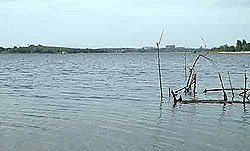China signs 16 agreements with Sri Lanka
Updated: 2012-09-18 08:05'Asia's miracle' embraces investment and friendship from Beijing
China signed 16 agreements with Sri Lanka on Monday, ranging from visa exemption and marine development to economic and technology cooperation, and promised to expand investment and increase imports from the South Asian country.
Experts said the expanded cooperation demonstrates deepened political trust, and will help make Sri Lanka "Asia's miracle" in terms of economic growth.
The two countries have agreed that holders of diplomatic and service passports of the other country will be exempt from visa requirements. Cooperation on marine development and management, and economic and technological cooperation, will be boosted.
Other agreements include favorable loans offered by Chinese banks to some major infrastructure projects in Sri Lanka and cooperation on telecommunication and railway system renovation. No details of these agreements have been revealed.
Sri Lankan President Mahinda Rajapakse and visitor Wu Bangguo, China's top legislator, witnessed the signing ceremony of the agreements.
Wu arrived in Colombo on Saturday to start the first ever visit by the chairman of China's National People's Congress Standing Committee.
Wu is also the highest-ranking Chinese official to visit Sri Lanka since the island nation ended longtime civil war with the separatist Tamil Tiger guerrillas three years ago.
During a meeting with Rajapakse on Monday, Wu said China will continue to adopt various measures to increase imports from Sri Lanka and will encourage more Chinese enterprises to invest in the country.
He proposed the two countries maintain and expand cooperation in infrastructure construction and will expand collaboration in new sectors such as marine scientific research, climate change, disaster prevention and relief, animal husbandry, agriculture product processing, bio-energy and tourism.
Commenting on concerns that China is attempting to increase its influence over South Asia by expanding cooperation with Sri Lanka, Sun Shihai, president of the Chinese Association for South Asian Studies, said Chinese assistance to Sri Lanka does not negatively affect a third party.
He said that with the development of globalization, China and South Asian countries will engage in more communication and cooperation, which will have global benefits.
Rajapakse said Sri Lanka is now devoted to becoming "Asia's miracle" and there is a great need for infrastructure construction and the training of professionals. He said the country welcomes Chinese investment and would like to offer favorable policies for big infrastructure projects such as the railway, ports and power generation stations.
Since the Sri Lankan military defeated the Tamil Tiger rebels three years ago, the country has undergone rapid development. It recorded a strong GDP growth of 8 percent in 2010 and 8.3 percent in 2011, according to official figures.
The Sino-Sri Lankan bilateral trade volume reached $3.14 billion in 2011 - up 49.8 percent year-on-year, according to China's Ministry of Foreign Affairs.
China also remains involved in almost all the large-scale projects under construction in Sri Lanka. Some of the biggest projects financed by China include a $1.3 billion coal power plant on the northwestern shore and a host of other investments in the south including a $1.2 billion port and a $209 million airport, according to figures from the Chinese government.
China has also pledged $760 million to improve the country's road network and is heavily involved in highway construction.
Hu Shisheng, an expert on South Asian studies with the China Institutes of Contemporary International Relations, said Sino-Sri Lankan cooperation has a broad spectrum, and the visa exemption policy shows the deepened political trust between the two countries.
After the civil war, Sri Lanka urgently needs to rebuild its infrastructure, which offers great opportunities for China, while China also seeks to increase overseas investment, so both countries have a strong will to cooperate, Hu said.
Sirimal Abeyratne, head of the economics department in the University of Colombo, said he is upbeat about the benefits of Wu's visit not just on political grounds but also on economic cooperation.
Abeyratne said the Sri Lankan government should work toward the expansion of trade between the two countries and not simply depend on loans in order to make the economic growth of the country sustainable. He noted that Sri Lanka's exports to China correspond to 1 percent of the island's total trade.
"Trade between the two countries is still at an early stage but is very important given the size and depth of China's market. Relations need to expand beyond investment and loans. Then it would be enormously beneficial for Sri Lanka," he told Xinhua News Agency.
Zhou Wa in Beijing contributed to this story.
Contact the writer at zhuzhe@chinadaily.com.cn
http://www.chinadaily.com.cn/world/2012-09/18/content_15764212.htm













